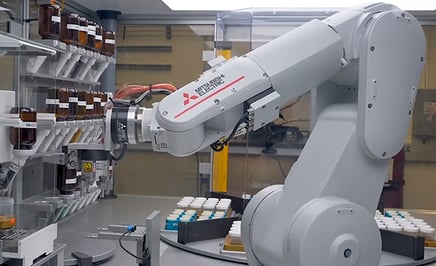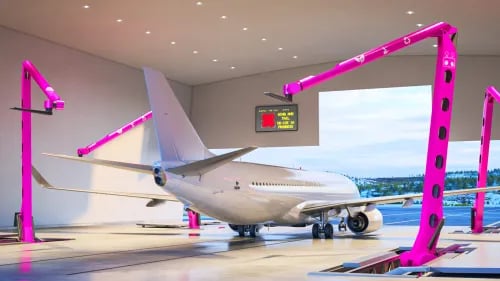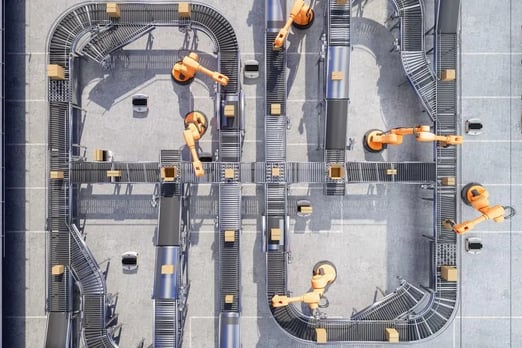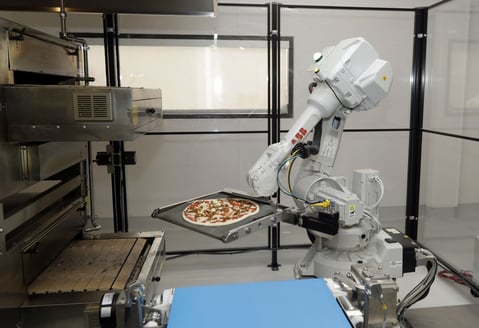What’s New in Robotics? 08.12.2023

Posted on Dec 08, 2023 7:15 AM. 8 min read time
News briefs for the week: Take a look at the mind-blowing discovery of 400K stable, new materials using DeepMind's AI and robots, giant robots cleaning and inspecting passenger jets for a whopping savings of $13.5 billion, robotics influencing customers while driving "The Amazon Effect," and Zume's robot pizza flop burns through $445 million.
Robots and AI discover 400K new materials
“A lot of the technologies around us, including batteries and solar cells, could really improve with better materials,” says Ekin Dogus Cubuk, who leads the materials discovery team at Google DeepMind in London.
By new materials, Cubuk means “stable” materials that normally can resist changes in their chemical composition, despite exposure to air, water, and heat. For example, “scientists with the University of Chicago have discovered a way to create a material that can be made like a plastic, but conducts electricity more like a metal.”
 Discovering new, stable materials—lots of them!—is an autonomous system that combines robotics with artificial intelligence (AI) to create entirely new materials. Known as the A-Lab, AI devises recipes for materials—more like reasoned guesses from machine learning—and then robots go to work mixing the recipe’s ingredients. Tirelessly 24/7, the A-Lab mixes tens of thousands of compounds until it finds a new stable material.
Discovering new, stable materials—lots of them!—is an autonomous system that combines robotics with artificial intelligence (AI) to create entirely new materials. Known as the A-Lab, AI devises recipes for materials—more like reasoned guesses from machine learning—and then robots go to work mixing the recipe’s ingredients. Tirelessly 24/7, the A-Lab mixes tens of thousands of compounds until it finds a new stable material.
For centuries, chemists have painstakingly done the same by hand, coming up with maybe 10,000 new stable materials. Lawrence Berkeley National Laboratory (LBNL) in Berkeley, California —used the A-lab system and collectively came up with about 48,000 stable materials in weeks!
DeepMind London has now supersized this approach with an AI system called graph networks for materials exploration or GNoME.  After training on data scraped from the Materials Project and similar databases, GNoME tweaked the compositions of known materials to come up with 2.2 million potential compounds.
After training on data scraped from the Materials Project and similar databases, GNoME tweaked the compositions of known materials to come up with 2.2 million potential compounds.
“After calculating whether these materials would be stable, and predicting their crystal structures, the system produced a final tally of 381,000 new inorganic compounds to add to the Materials Project database.”
Giant robots: big savings washing passenger jets
If all 28,000 commercial passenger jets in the global fleet were washed monthly, the cleaning would save 2% on jet fuel consumed. With worldwide jet fuel consumption for 2023 at 86 billion gallons and the price of jet fuel at $6.75 a gallon, that’s a reduction of 2 billion gallons for a whopping savings of $13.5 billion.
 Norwegian startup Avinxt is building massive AI robots to both clean and inspect passenger jets.
Norwegian startup Avinxt is building massive AI robots to both clean and inspect passenger jets.
According to Avinxt, a large passenger jet can take up to 24 hours to clean, which is why most airlines only wash them every 2 to 6 months; yet dirty aircraft are responsible for about 2.5% of global carbon emissions.
Additionally, Avinxt’s enormous robots can quickly and sustainably wash, de-ice, and inspect passenger jets. The company’s AI robots, with their combination of cameras and AI software, allow them to clean a plane’s entire body and engine in about 75 minutes. An inspection, meanwhile, takes just 7 hours, compared to days or even weeks if done manually.
“There is no reason why airports, airlines, the air force, and ground handlers should continue with manual, time-consuming, and expensive processes,” said Ove Trøen, CEO and chairman of Avinxt.
The company will begin building their giant robots at Oslo Airport in 2024, and then at London’s Gatwick for Norse Atlantic Airways’ hub.
Robotics, the engine driving “The Amazon Effect”
How do robots influence consumers?
2024 will be the first year that generative AI is with us from New Year’s Day onward, and its impact on e-commerce is forecast to explode. A recent Deloitte report sees the year ahead in generative AI going from potential to real productivity and will reshape multiple industries in 2024.
 With nearly 60% of consumers across the globe preferring online to in-store shopping, according to GWI research, e-commerce, if logistics can take full advantage of generative AI, has the opportunity to move the needle of 60% online shopping much higher, and along with it, billions of new dollars.
With nearly 60% of consumers across the globe preferring online to in-store shopping, according to GWI research, e-commerce, if logistics can take full advantage of generative AI, has the opportunity to move the needle of 60% online shopping much higher, and along with it, billions of new dollars.
No one in e-commerce seems more ready for such an eventuality than Amazon, with a nearly 40% share of online as of 2023. With a robotic workforce of 750,000 that is 10 years in the making, adding generative AI to those tens of thousands of robots could result in a staggering windfall.
The robots are expensive. Yahoo Business claims that Amazon has spent $35 billion building out its army of robots.
Amazon’s impact on retail, what is called “The Amazon Effect” is simultaneously changing customer perceptions on the benefits of buying online as well as sending a wake-up call for retailers on how robots can attract and keep customers.
In 2024, brands that emulate Amazon’s strategy “can also ride the wave of e-commerce affinity that Amazon has ushered in and succeed alongside it.”
But, can they pull it off?
Amazon’s robot advantage is built in a secretive robot factory and R&D space in Massachusetts called Bos 33. This week, 3 December 2023, Yahoo Finance’s new program NEXT put together a 17-minute video on Bos 33, with a forecast for 2024 for robots and generative AI, including expert interviews from third-party sources.
Zume’s pizza robot flop burns through $445M
Back in 2018, Zume Inc. was hellbent on automating the preparation and delivery of hot pizza.
Here’s what Forbes wrote about CEO Joe Garden back then: “Zume Inc., which was founded in 2015, added its new robot, “Vincenzo,”  in June to remove pizzas from 800-degree ovens. Vincenzo joins Zume’s other robots that recognize when pizzas are done, spread pizza sauce and move pizzas to racks. The company has turned the heads of some investors and, according to Bloomberg, SoftBank is in talks to invest up to $750 million in Zume.”
in June to remove pizzas from 800-degree ovens. Vincenzo joins Zume’s other robots that recognize when pizzas are done, spread pizza sauce and move pizzas to racks. The company has turned the heads of some investors and, according to Bloomberg, SoftBank is in talks to invest up to $750 million in Zume.”
Wow, how lucky was SoftBank. Today, it's all gone. Zume Inc. has folded along with its owner’s dreams of delivering hot pizza to customers.
As a point of comparison, Zume lost more money than the total annual revenue from Columbus, OH-based Donatos Pizzeria, with its 170 shops ($443 million 2022).
Zume’s special knack for becoming, as someone once boasted, “The Amazon of Pizza”, was to make pizza with robots in a warehouse and then finish them off in kitchens on wheels (like a roving restaurant delivery van) while driving to a customer’s home or apartment.
 According to Bloomberg, cooking pizza while delivering it presented technical challenges that were never sufficiently overcome.
According to Bloomberg, cooking pizza while delivering it presented technical challenges that were never sufficiently overcome.
Zume made a series of layoffs in 2020, cutting headcount by more than 500 employees — including all of its robotics and food-delivery truck business.
Garden, who filed a patent in 2013 for cooking food as it was being delivered, would become Zume’s “bake-on-the-way” process. Garden believed that automating pizza-making—using robots to construct the pies—would cut production costs. “Better margins meant more money for high-quality ingredients and “better jobs”—not the sort of dull, repetitive tasks common in foodservice.” Garden reasoned, he could beat the corporate pizza chains at their own game. Unfortunately, Garden had no experience in food, restaurants, or robotics.
By the time 2023 rolled into view, Zume was "insolvent." Sherwood Partners, a restructuring firm, was then instructed to sell the company's assets.
Zune ceased to be, and along with it nearly a half billion dollars from investors from the likes of Grishin Robotics, MicroVentures, FJ Labs, Kleiner Perkins, SGH Capital, AME Cloud Ventures, Maveron, and SignalFire.


Leave a comment